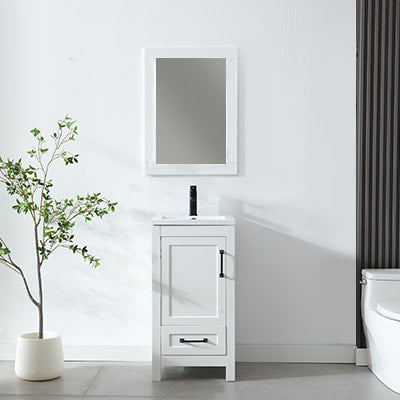Looking to refresh your outdated bathroom without breaking the bank? This DIY tutorial is for you.
Have you ever stared at that outdated but structurally sound bathroom vanity in your home, feeling conflicted? It seems wasteful to discard it, yet keeping it affects the bathroom's overall aesthetics. Actually, just one weekend of hands-on work can breathe new life into your old 48 inch bathroom vanity through partial refinishing, saving you money while providing the satisfaction of DIY accomplishment.
👜Preparation: Tools and Materials Checklist

Before starting your refinishing project, gather the following tools and materials:
Essential Tools: Screwdrivers (Phillips and flat-head), pipe wrench, sandpaper (240-grit and 400-grit), hammer, power drill, scraper, paint brushes or spray gun.
Protective Materials: Drop cloths, painter's tape, gloves, mask.
Refinishing Materials: Water-based wood paint (varnish or colored paint), talcum powder or putty (for filling dents), sealant.
Replacement Parts: New bathroom sink, new faucet, new handles and other hardware.If you're looking for a more comprehensive upgrade, consider browsing our extensive collection of 48-inch bathroom vanities, many of which come with integrated sinks and modern hardware.
Safety First: Ensure adequate ventilation in your workspace. Turn off power and water supply before beginning.
🔗Step 1: Disassembling the Vanity and Old Components

Shut Off Water Supply and Disconnect Pipes
First, turn off the angle stop valves beneath the sink (rotate clockwise). Use a screwdriver to remove screws securing the 48 vanity cabinet to the wall. If screws are rusted, apply lubricant and wait a moment before attempting removal. During disassembly, maintain cabinet integrity and be careful not to damage walls and pipes.
Remove Old Faucet and P-Trap
Reach beneath the sink and use a screwdriver or socket tool to remove screws and mounting plates securing the faucet. Lift the old faucet out from above the sink. Use a wrench to loosen screws or connections attaching the drain pipe to the old sink.
Disassemble the Cabinet
Use a screwdriver to remove screws securing the vanity to the wall. If screws are rusted, apply lubricant and wait a moment before attempting removal. During disassembly, maintain cabinet integrity and be careful not to damage walls and pipes.
🔍Step 2: Surface Preparation and Refinishing

Cleaning and Sanding
Use a high-power blower to remove accumulated dust from the bathroom vanity cabinet, avoiding wet cloths. Sand the surface with 240-grit sandpaper to remove old paint and grease. For stubborn residues, use a scraper carefully. Maintain consistent sanding direction to avoid noticeable scratches.
Filling and Repairing
Fill wood gaps, nail holes, and dents with talcum powder or putty. Apply slightly above surface level, then sand smooth with 240-grit paper once completely dry. For severe damage, repair with matching wood material.
Painting and Refinishing
Choose varnish or colored paint based on preference. Varnish preserves wood grain, while colored paint completely transforms the style. Use painter's tape to protect surrounding areas before painting. Follow the "top to bottom, inside out" sequence, working quickly with thin coats.
Water-based wood paint typically requires "two primer coats, one top coat" or "one primer, two top coats." Allow each coat to dry completely (approximately 6 hours at room temperature), then lightly sand with 40-grit paper before applying the next coat.
🔨Step 3: Replacing Sink and Installing New Hardware

Installing New Sink
Before installation, clean and dry the countertop surface. Follow manufacturer's instructions to install sealing gaskets around the sink rim. Carefully place the new 48 inch vanity with sink into the countertop opening, ensuring proper alignment with cabinet edges. Secure from below using screws and mounting plates.
Installing New Faucet
Connect hot and cold water lines to correct faucet ports: red indicator for hot water line (left side), blue for cold water line (right side). Slide decorative rings onto faucet base, insert faucet into sink holes. From below, install rubber washers, metal mounting plates, and tighten nuts.
Connecting Drain Pipe
Connect drain pipes to the new sink's drain opening. Use a wrench to secure connections, ensuring no looseness.
Installing New Hardware
Install new handles and hinges at marked positions. Use painter's tape on drilling marks to prevent wood splitting. Ensure all hardware is securely installed and consistently positioned.
🔫Step 4: Final Assembly and Testing

Reinstalling the Cabinet
Position the refinished 48 inch bathroom vanity cabinet back against the wall. Use a level to ensure proper alignment. Secure the cabinet to the wall using pre-marked holes, avoiding concealed pipes and wires.
Testing
Turn on angle stop valves and check for leaks around faucet and connections. Block the drain, fill with water, and test drainage efficiency. Operate the faucet, adjusting water flow and temperature control to ensure proper function.
Final Adjustments
For minor leaks, tighten connections appropriately or apply plumber's tape to pipe threads. Check door operation smoothness and make necessary adjustments.
📌Maintenance and Care After Refinishing
The refinished 48 vanity with sink requires about 7 days of curing—avoid placing heavy objects, hot water, or wet towels on the surface during this period. For daily cleaning, use neutral cleaners and soft cloths only, avoiding chemical solvents like alcohol or gasoline. Maintain proper bathroom ventilation and ensure adequate dry-wet separation to extend the bathroom vanity's lifespan.
💡Conclusion
Through this DIY refinishing project, you can save approximately 50%-70% in costs (compared to buying a new 48 double sink vanity) while enjoying the satisfaction of hands-on transformation. Giving old items new life adds unique stories and warmth to your home. Take advantage of a weekend to give your old 48 inch double vanity a second life!
Important Notes: If your bathroom vanity is made of high-grade solid wood (e.g., rosewood, yellow pear wood), consult professionals to avoid value loss from improper refinishing.




